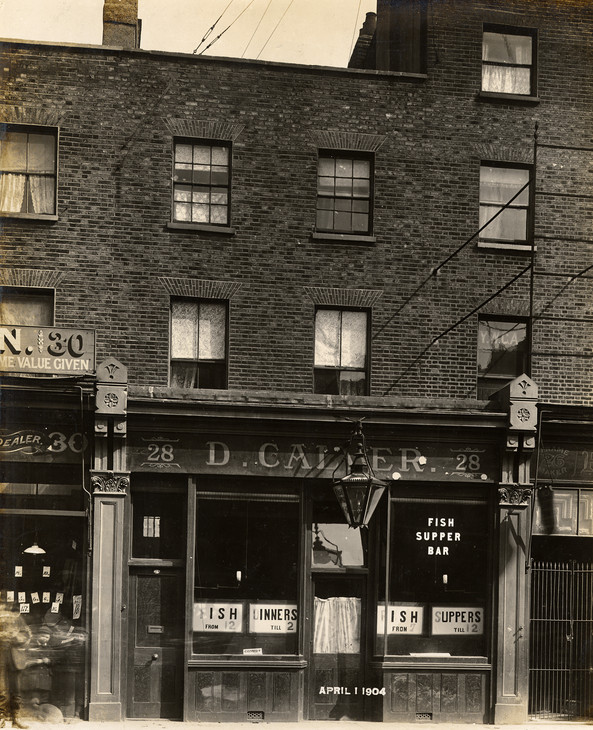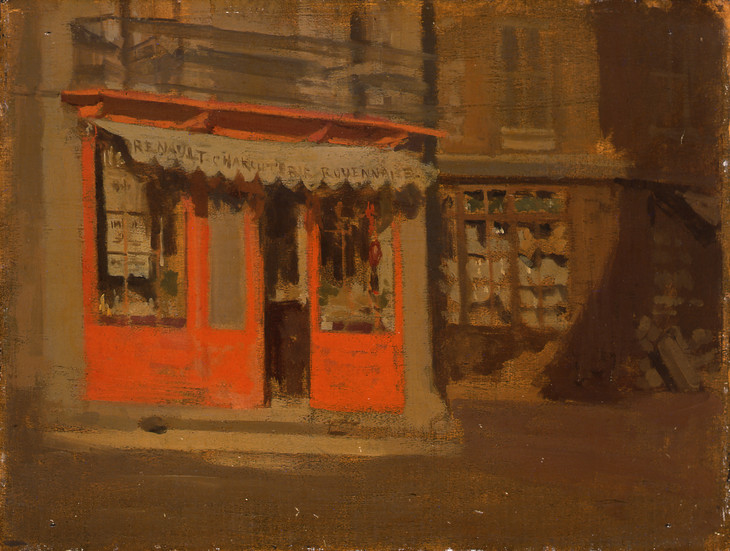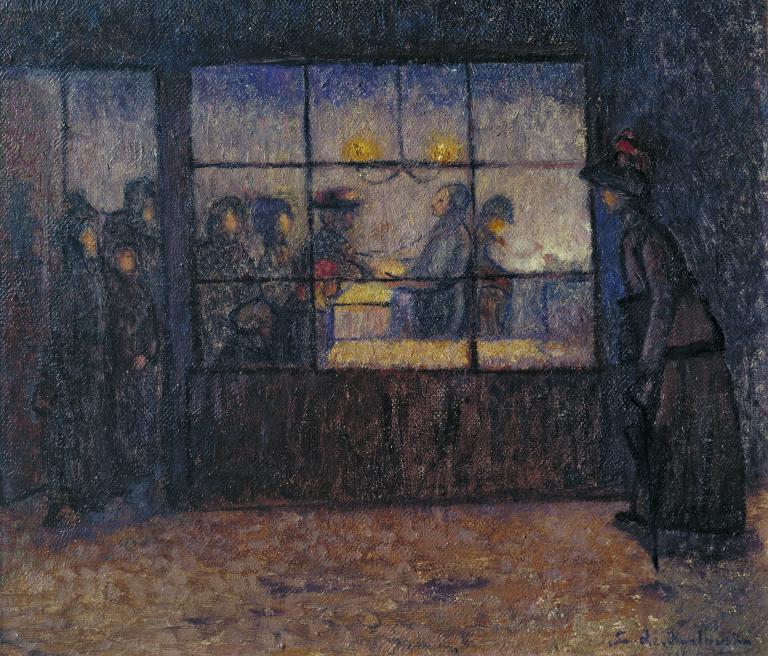Stanislawa De Karlowska Fried Fish Shop c.1907
Stanislawa De Karlowska,
Fried Fish Shop
c.1907
Fried fish shops were extremely popular among the working classes in early twentieth-century London. The cloud of smoke billowing above the grill and the shop’s counter are the only features indicating the type of commerce engaging the line of patrons, including small children, crowding in under the shop’s yellow gaslight.
Stanislawa de Karlowska 1876–1952
Fried Fish Shop
c.1907
Oil paint on canvas
330 x 390 mm
Inscribed ‘S. de. Karlowska’ bottom right
Presented by the artist’s family 1954
N06238
c.1907
Oil paint on canvas
330 x 390 mm
Inscribed ‘S. de. Karlowska’ bottom right
Presented by the artist’s family 1954
N06238
Ownership history
By descent to Robert Alexander Bevan (1901–1974), the artist’s son, and presented by him and the artist’s family to Tate Gallery 1954.
Exhibition history
1910
Third Exhibition of the Allied Artists’ Association, Royal Albert Hall, London, July 1910 (633).
1911
Twelfth Exhibition of the Women’s International Art Club, Grafton Gallery, London, March 1911 (69).
1954
Memorial Exhibition of Paintings by S. de Karlowska, Adams Gallery, London, October 1954 (1).
1987–8
The Edwardian Era, Barbican Art Gallery, London, November 1987–February 1988 (127, reproduced).
References
1911
Huntly Carter, ‘Art’, New Age, 16 March 1911, pp.474–5.
1911
Frank Rutter, ‘Round the Galleries’, Sunday Times, 19 March 1911, p.5.
1955
Tate Gallery Report 1954–55, London 1955, p.17.
1964
Mary Chamot, Dennis Farr and Martin Butlin, Tate Gallery Catalogues: The Modern British Paintings, Drawings and Sculpture, vol.1, London 1964, p.349.
1996
Mireille Galinou and John Hayes, London in Paint: Oil Paintings in the Collection at the Museum of London, London 1996, p.374.
Technique and condition
Fried Fish Shop was painted over an earlier painting that was cut down and obliterated with white paint. The canvas is a plain weave cloth, probably linen, with double warp and weft threads. It appears to be commercially prepared, with animal glue sizing and white oil priming. The original painting has been cut down at the top, bottom and right-hand edges and then re-stretched. A layer of stiff white paint, which has filled the canvas weave texture and imparted an overall brushed texture, was applied to mask the earlier work. During painting the support was again modified, by flattening the left-hand tacking margin to extend the left edge and re-stretch it. The old tacking margin is now visible as a vertical ridge running down the left-hand side of the painting.
The earlier picture underneath is visible where there have been losses around the tacking margins. Layers of coloured and white paint from the second painting campaign have flaked off to reveal orange paint over the original white priming. Fried Fish Shop is composed of several coloured layers applied over the white under-layer. The lower layers of the picture are mainly thin scumbled paint through which the white under-layer remains visible. Drawing is reinstated during painting with strong dark brush lines. The final modifications were applied after the painting had been re-stretched to its current size. These dabs and streaks of more opaque paint modify the glowing colour of the night and define the forms. The overall effect is of contrasting light and application; the warm glow of the shop interior contrasts with the amorphous cool darks of the foggy street outside.
The condition of the painting reflects its complex construction and history. Following re-stretching during painting, networks of cracks formed and small areas of paint flaked away from around the tacking edges where the bond between the earlier and later painting is weak.
Sarah Morgan and Roy Perry
May 2004
How to cite
Sarah Morgan and Roy Perry, 'Technique and Condition', May 2004, in Robert Upstone, ‘Fried Fish Shop c.1907 by Stanislawa de Karlowska’, catalogue entry, May 2009, in Helena Bonett, Ysanne Holt, Jennifer Mundy (eds.), The Camden Town Group in Context, Tate Research Publication, May 2012, https://wwwEntry
Shops selling fried fish and chips were to be found in large numbers in London by the date this picture was made (fig.1). This kind of food was characterised as a staple of working class diet, although in many cases it was in fact a more occasional luxury. It was extremely popular, and at this time considered highly nourishing. However, the noxious odours given off by the poor quality oils frequently used for frying led to numerous prosecutions for public nuisance in the early years of the century. Fried fish shops were viewed with disdain by the middle classes, both for their smell and their popular working class ethos. In the Public Health Act of 1907 – the same date as this picture – fried fish shops were specifically designated an ‘offensive trade’, and fryers came under strong pressure to use better quality oils and hoods to collect the fumes.1

Ernest Milner 1862–1933
London Transport photograph of D. Calver, Fish Supper Bar, 28 Camden High Street 1 April 1904
Photographic print
277 x 227 mm
Camden Local Studies and Archives Centre
Photo © Camden Local Studies and Archives Centre
Fig.1
Ernest Milner
London Transport photograph of D. Calver, Fish Supper Bar, 28 Camden High Street 1 April 1904
Camden Local Studies and Archives Centre
Photo © Camden Local Studies and Archives Centre

Walter Richard Sickert 1860–1942
The Red Shop (The October Sun) c.1888
Oil on panel
267 x 356 mm
Norwich Castle Museum and Art Gallery
© Estate of Walter R. Sickert / DACS 2010
Photo © Norwich Castle Museum and Art Gallery
Fig.2
Walter Richard Sickert
The Red Shop (The October Sun) c.1888
Norwich Castle Museum and Art Gallery
© Estate of Walter R. Sickert / DACS 2010
Photo © Norwich Castle Museum and Art Gallery
Karlowska painted a related shop subject in 1914, The Wine Shop (private collection).2 This shows a shop interior, but has a very similar composition and approach in distributing the figures across the span of the picture. It is painted in a more adventurous palette, principally of red and green. Comparison might be drawn with Walter Sickert’s small number of much earlier and very different paintings of French shop fronts made in the late 1880s such as The Red Shop (fig.2). These are more conventionally impressionist in style, and do not include figures, but in some degree are similar in intent. Karlowska’s focus in Fried Fish Shop lies principally in the figures rather than the shop which, apart from its counter, is almost without feature. There is a strong sense of London life glimpsed in passing, a snapshot of working class experience from the vantage of the pavement. The picture is also an exercise in capturing the fall of yellow gaslight through the shop window, penetrating the gloom of the street.
In 1910 Karlowska’s work had attracted critical praise from the art critic Huntly Carter, who was a supporter of other future members of the Camden Town Group circle, notably Spencer Gore and Harold Gilman. He was particularly interested in the emotive potential of colour, and partly for this reason seems to have been attracted to Karlowska. He also wrote favourably in the New Age about women painters:
That the work of the Women’s International Art Club, now being exhibited at the Grafton Galleries, is above the average is clear from the beginning. In the first room one meets with at least half a dozen women who have something uncommonly interesting to say in paint. Among them are three artists who are painting in colour, whose work is frank and honest, and not disposed of with a few fierce dashes of the brush, but in a complete, substantial, and emphatic way. What S. de Karlowska has to say she tells us lucidly in pure and harmonious colour. Her two studies of still life speak in the broadest, simplest, and most convincing terms.3
Writing of Fried Fish Shop when it was exhibited with the Women’s International Art Club in 1911, Carter wrote:
A welcome contrast to this ‘shouting angel’ [Anne Estelle Rice’s Egyptian Dancers] is found in S. de Karlowska’s delicate shade of colour thought beneath. Restful indeed are the quiet subtle harmonies of blue and yellow, while the soft steamy oily atmosphere lifts the common ‘Fried Fish Shop’ into the realm of poetry.4
The art critic Frank Rutter also wrote favourably of Fried Fish Shop:
Lower in tone than anything on this wall ‘The Fried Fish Shop,’ by S. de Karlowska (Mrs. R.P. Bevan), is a delightful and wholly personal rendering of a common Whistler subject transfigured by a vibrating luminism that was unknown to Whistler.5
Robert Upstone
May 2009
Notes
Related biographies
Related essays
- Leisure Interiors in the Work of the Camden Town Group Jonathan Black, Fiona Fisher and Penny Sparke
- A History of Camden Town 1895–1914 David Hayes
- Sex and the City: The Metropolitan New Woman Meaghan Clarke
How to cite
Robert Upstone, ‘Fried Fish Shop c.1907 by Stanislawa de Karlowska’, catalogue entry, May 2009, in Helena Bonett, Ysanne Holt, Jennifer Mundy (eds.), The Camden Town Group in Context, Tate Research Publication, May 2012, https://www


